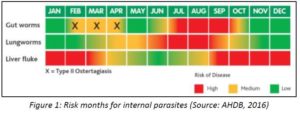Weaning
At around turnout, autumn-calving herds can wean their calves, where the better-quality pasture can be allocated for calves and cows can be put on poorer quality grazing; this can help with controlling cattle BCS. This allows farmers to meet the requirements of:
- Growing calves, through good quality grazing and management. If it is necessary, a supplementary feed can be easily introduced and ready for the winter ration, calves can also become accustomed to this in an easily managed way.
- For dry cows, to control BCS to meet the target for calving (2.5-3.0), the poorer grazing on the farm is well suited to the group, where feeding can be restricted, with the addition of straw to satisfy appetite if necessary.
The grazing season provides an opportunity for cows to store excess energy, which can be mobilised during the winter, where management to gain 0.5-1.0 BCS may be beneficial. For cows and calves which are weaned during summer, issues regarding the condition of cows whilst providing good quality grazing for the calves can be encountered. Ways which can mitigate this:
- Creep feeding the calf.
- Forward creep grazing the calf (allow the calf to “creep” into a field ahead of cows).
- Wean earlier: This can allow calves to be grazed on high-quality pasture, to promote growth rates.
- Cows can be grazed on poorer quality grazing to ensure they do not gain excessive weight.
Grazing management
Grazed grass typically contributes over 50% of total feed intake of autumn-calving herds and over 65% for spring calving herds, highlighting the importance of good grazing management. To match grass quality and quantity, stocking densities can be high during the spring and then eased off in the autumn, keeping an eye on sward height and grass quality. Electric fences should be used to shut off the grazed ground to allow for optimum re-growth and artificially manage stacking density.

Parasites
Parasites impact the performance of the animal and can increase times to achieve target weights and condition. Youngstock animals are most at risk as they will have little to no immunity. Figure 1 highlights key risk months for gut worms, lungworms and liver fluke.

Supplementation at Grass
Magnesium is an essential major mineral required as Mg takes part in many functions in the ruminant, from activation of enzymes to an important component for regulating blood calcium. Mg homeostasis is not regulated by hormone function, requiring the need to supplement through intakes.
For suckler cattle and livestock at grass, there are many factors which can impact the absorption of Mg highlighted below, where management is key to ensure absorption of Mg:
- Potassium is an antagonist for absorption. This can be high in grazed grass.
- Aluminium in the diet can reduce the absorption and can be done through soil contamination. Management of sward height to eliminate overgrazing (soil contamination) can help.
- Rumen passage rate; the high moisture spring flush increases passage rate where rumen microbes have limited time to absorb any Mg.
- High dietary N- until the microflora has adapted and stabilized.
Requirements

Supplementing Mg
There are several ways to supplement Mg:
- Infeed mineral: for those to supplementary feed sucklers out on poor quality pasture and cattle which are getting concentrates.
- Buckets: arguably the most common form of supplementing suckler cows. Keep in mind cows with bull calves; if the calves start to nibble at the buckets- remove the bucket (we do not want to promote urinary calculi).
- Mg in water- again this is something which would only be advised to feed to females. It is also difficult to gauge water intakes and is not the most efficient way to supplement Mg to cows.
- Pasture dusting- spread magnesium across the pasture, however, wastage can be as high as 50%.
Speak to your local NWF Sales Specialist, or call 0800 756 2787 for more information on our range of feeds, blends and more.
Trouw Nutrition GB | AHDB| Teagasc
